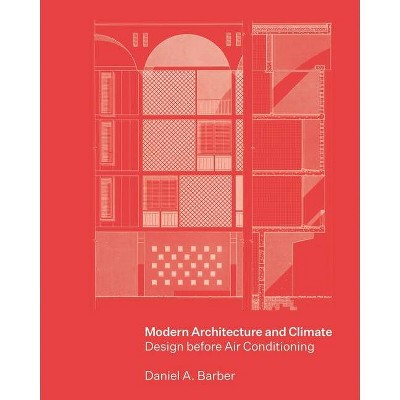Modern Architecture and Climate - by Daniel A Barber (Hardcover)

Similar Products
Products of same category from the store
AllProduct info
<p/><br></br><p><b> About the Book </b></p></br></br>"Modern Architecture and Climate explores how leading architects of the twentieth century incorporated climate-mediating strategies into their designs, and shows how regional approaches to climate adaptability were essential to the development of modern architecture. Focusing on the period surrounding World War II-before fossil-fuel powered air-conditioning became widely available-Daniel Barber brings to light a vibrant and dynamic architectural discussion involving design, materials, and shading systems as means of interior climate control. He looks at projects by well-known architects such as Richard Neutra, Le Corbusier, Lâucio Costa, Mies van der Rohe, and Skidmore, Owings, and Merrill, and the work of climate-focused architects such as MMM Roberto, Olgyay and Olgyay, and Cliff May. Drawing on the editorial projects of James Marston Fitch, Elizabeth Gordon, and others, he demonstrates how images and diagrams produced by architects helped conceptualize climate knowledge, alongside the work of meteorologists, physicists, engineers, and social scientists. Barber describes how this novel type of environmental media catalyzed new ways of thinking about climate and architectural design. Extensively illustrated with archival material, Modern Architecture and Climate provides global perspectives on modern architecture and its evolving relationship with a changing climate, showcasing designs from Latin America, Europe, the United States, the Middle East, and Africa. This timely and important book reconciles the cultural dynamism of architecture with the material realities of ever-increasing carbon emissions from the mechanical cooling systems of buildings, and offers a historical foundation for today's zero-carbon design"--<p/><br></br><p><b> Book Synopsis </b></p></br></br><p><b>How climate influenced the design strategies of modernist architects</b> <p/><i>Modern Architecture and Climate</i> explores how leading architects of the twentieth century incorporated climate-mediating strategies into their designs, and shows how regional approaches to climate adaptability were essential to the development of modern architecture. Focusing on the period surrounding World War II--before fossil-fuel powered air-conditioning became widely available--Daniel Barber brings to light a vibrant and dynamic architectural discussion involving design, materials, and shading systems as means of interior climate control. He looks at projects by well-known architects such as Richard Neutra, Le Corbusier, Lúcio Costa, Mies van der Rohe, and Skidmore, Owings, and Merrill, and the work of climate-focused architects such as MMM Roberto, Olgyay and Olgyay, and Cliff May. Drawing on the editorial projects of James Marston Fitch, Elizabeth Gordon, and others, he demonstrates how images and diagrams produced by architects helped conceptualize climate knowledge, alongside the work of meteorologists, physicists, engineers, and social scientists. Barber describes how this novel type of environmental media catalyzed new ways of thinking about climate and architectural design. <p/>Extensively illustrated with archival material, <i>Modern Architecture and Climate</i> provides global perspectives on modern architecture and its evolving relationship with a changing climate, showcasing designs from Latin America, Europe, the United States, the Middle East, and Africa. This timely and important book reconciles the cultural dynamism of architecture with the material realities of ever-increasing carbon emissions from the mechanical cooling systems of buildings, and offers a historical foundation for today's zero-carbon design.</p><p/><br></br><p><b> Review Quotes </b></p></br></br><br>Richly illustrated. . . . For the academic and the architect, this valuable volume encourages more careful consideration of climatic modernism as both history and limit. It is thought-provoking, giving us pause to consider the passionate attempts that architects have made to mediate their environment. The tales gathered here trace a lineage that situates design within the planetary. . . . Barber's constant and learned skepticism warns us to maintain an informed but critical distance from the pursuit of immediate comfort.<b>---Hannah Le Roux, <i>Journal for the Society of Architectural Historians</i></b><br><br>Daniel Barber's historical narrative is fascinating and holds many useful lessons for a contemporary audience.<b>---Brian Ford, <i>The Plan Journal</i></b><br><br>I've waited years for a book like this... <i>What Modern Architecture and Climate </i>suggests is an alternative reckoning with modernism's legacy--its ideas, strategies, and practitioners. With the urgency of our global climate crisis, many of these concerns are once again central...Barber's book points us in the right direction.-- "Arris"<br><br>[An] exhaustively researched book . . . [in <i>Modern Architecture and Climate</i>] Barber makes a well-supported argument that through the propagation of this very specific set of cultural and <i>Modern Architecture and Climate</i> comfort ideals, modern architecture became an instrument for globalization, economic development, and postwar colonialism.<b>---Kristin Schuster, <i>Texas Architect Magazine</i></b><br><br>[Daniel] Barber's thorough account, written in the distanced expert voice of a historian, shines when it dispels established beliefs . . . [<i>Modern Architecture and Climate</i>] does an excellent job of documenting the subjects it cover.<b>---Ross Wienert, <i>Rice Design Alliance</i></b><br><br><i>Modern Architecture and Climate</i> is a fresh and original history that chronicles the intense research undertaken by designers to adapt modernist architecture to various climate conditions, as modernism's political and aesthetic influence reached across the globe. . . . Barber's work is a welcome addition to the history of architectural modernism, and is particularly pertinent in our current circumstances. It demonstrates the profound impact that our expectations of a uniform interior have had on the planet we share. But its examples also offer an inspiring model for challenging assumptions about the role of building form in mitigating climate extremes.<b>---Javier Zeller, <i>Canadian Architect</i></b><br><br>[<i>Modern Architecture and Climate</i>] offers . . . the most comprehensive and concise corrective to the reigning histories of Modernism that have tended to exclude, or at least consider only superficially, environmental context.<b>---Russell Fortmeyer, <i>Architectural Record</i></b><br><br>Barber's book is not simply a technological history, but ultimately also an impassioned lament for our collective carbon footprint as planetary temperatures increase...Architects, engineers, and students interested in systematic and environmentally friendly approaches to indoor cooling will find inspiration in <i>Modern</i> <i>Architecture and Climate</i>....In a time of an airborne pandemic, <i>Modern Architecture and Climate</i>, with its rigorous examination of open interiors, airflow, and ventilation, will serve well those readers who have the grit to absorb the author's intensive approach and sobering message.<b>---Paul Glassman, <i>ARLIS/NA Reviews</i></b><br><br>It's easy to think of Modernism as inseparable from air conditioning, simply because we are surrounded by so much of it that is. A valuable reminder that this wasn't always the case is provided in Daniel A. Barber's <i>Modern Architecture and Climate: Design Before Air Conditioning</i>, which outlines the story of the febrile, flexible, and often-forgotten early experiments in climate control.<b>---Anthony Paletta, <i>Metropolis</i></b><br><br>The premise of [<i>Modern Architecture and Climate</i>] is this: The battle for the supremacy of air conditioning above all other solutions for climate mitigation was, in fact, a <i>battle . . . </i>[it] spanned continents, political ideologies, and architectural discourses...What makes Barber's book so interesting is not only the meticulous documentation of...climate-control alternatives and their practitioners, but the tension between their goals and their underlying ideologies. . . . The lesson from Barber's book is not to replicate the conditions that begat yesterday's missed opportunities, but to change them for the better.<b>---Kate Wagner, <i>The Architect's Newspaper</i></b><br><br>[An] erudite work...Heavily illustrated and deeply researched. . . . Academics, urban planners, and environmental designers will most appreciate this thought-provoking and detailed volume.-- "Publishers Weekly"<br><p/><br></br><p><b> About the Author </b></p></br></br><b>Daniel A. Barber</b> is associate professor of architecture at the University of Pennsylvania Weitzman School of Design. He is the author of <i>A House in the Sun: Modern Architecture and Solar Energy in the Cold War</i>. He lives in Philadelphia.
Price History
Cheapest price in the interval: 54.99 on October 23, 2021
Most expensive price in the interval: 54.99 on November 8, 2021
Price Archive shows prices from various stores, lets you see history and find the cheapest. There is no actual sale on the website. For all support, inquiry and suggestion messages communication@pricearchive.us




















